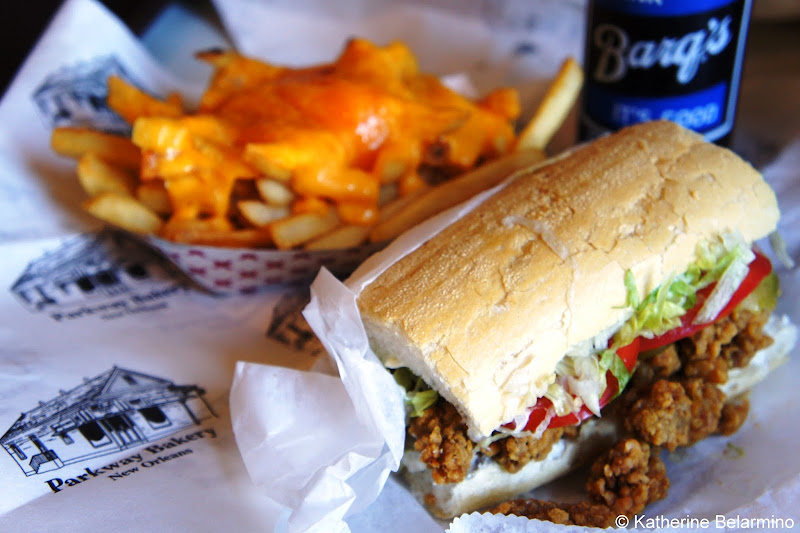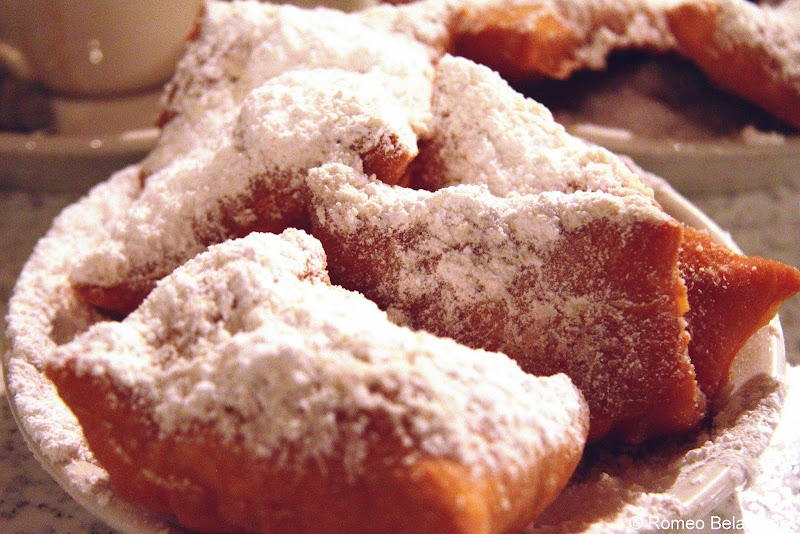 |
| Fried oyster po'boy at Parkway Bakery. |
New Orleans is one of America’s food meccas. The food isn’t just good, it’s historic. Many of New Orleans’ recipes have been around for 100 years or more. Travelers will want to eat the best and most traditional cuisine New Orleans has to offer. We made it our mission to discover and taste the best of New Orleans’ food as part of our list of things to do in New Orleans.
Related: 10 Top Restaurants in New Orleans
Alligator
The swamps of New Orleans are filled with alligators and so are the menus. Alligator can be found both in casual restaurants and fine dining establishments. While we are more used to seeing bisque of the lobster variety, Antoine’s serves Potage Alligator au Sherry, an alligator bisque seasoned and laced with sherry. The alligator bisque was like a rich stew with small chunks of alligator throughout.
Bread Pudding
 |
| Commander's Bread Pudding Soufflé. |
Bread pudding is a popular New Orleans dessert. Bread pudding’s origins are European, but New Orleans has embraced bread pudding and made it its own. One of the most decadent renditions of bread pudding in New Orleans can be found at Commander’s Palace. The Creole bread pudding at Commander’s Palace is whipped into a light soufflé and presented tableside with a warm whiskey cream.
Beignets
 |
| Beignets at Café Du Monde. |
Probably one of the first foods that come to mind when New Orleans is mentioned is beignets. Beignets were brought to New Orleans by Acadians, French colonists who came from Canada. Beignets are a simple dessert, fried square pieces of dough covered with powdered sugar. The most popular place to get beignets is Café Du Monde, which has been serving beignets since 1862. In the mornings, and sometimes in the afternoon, lines for a table can get very long, extending far down the block. If you want to avoid a long line, visit Café Du Monde at night, when you can usually grab a seat right away. Café Du Monde is open seven days a week, 24 hours a day.
Café Brûlot Diabolique
Café Brûlot Diabolique, which translates to Devilishly Burned Coffee, was created by Jules Alciatore of Antoine’s, the oldest family-run restaurant in the United States. Café Brûlot Diabolique is a traditional after dinner libation which became very popular during Prohibition as a way to conceal alcohol. Flaming drinks were all the rage in France and Jules brought the concept to New Orleans. The beverage is prepared tableside in a large ornate bowl and is served in special narrow cups that concentrate the aroma. Sugar cubes are rubbed with orange and lemon rinds and placed in demitasse cups. Cinnamon sticks, orange rinds, lemon rinds, cloves, and brandy are heated in the chafing dish and then flamed. Hot coffee is added and then the mixture is ladled into the demitasse cups. Café Brûlot Diabolique can also be found at Arnaud’s.
Chicory Coffee
Along with your beignets at Café Du Monde you need to order chicory coffee with milk. In addition to beignets, the Acadians also brought chicory coffee with them to Louisiana. Chicory is a root which was added by the Acadians to their coffee during the time of the French civil war as coffee was scarce and expensive and the addition extended the life of the coffee. They developed a taste for this mixture, so even when coffee became easier to attain and more affordable, chicory continued to be used. While chicory is now more expensive than coffee, the practice of including chicory in coffee has continued, and the addition provides a darker, richer and slightly sweeter taste.
Crawfish Etouffee
 |
| Crawfish etouffee at the Gumbo Shop. |
Crawfish were eaten in Louisiana by the Native Americans before the early settlers arrived. Crawfish, also known as mud bugs, can be found in the swamps of Louisiana. Crawfish haven’t always been popular. Some refused to eat them even during the Great Depression. Crawfish have become more popular, especially with the introduction of crawfish farming. If you’re willing to put in the dirty work of tearing off the heads and sucking out the insides of whole crawfish, head to Big Fisherman Seafood in the Garden District and buy a bag of boiled crawfish. If you aren’t quite ready to get that intimate with your seafood, try crawfish in the popular New Orleans dish crawfish etouffee. Etouffee is similar to gumbo in that it involves a thickening roux and is served over rice. Etouffee can be made with any shellfish, but the most popular is crawfish etouffee. The Gumbo Shop makes a great crawfish etouffee.
Gumbo
 |
| Chicken Andouille Gumbo at the Gumbo Shop. |
Gumbo is a traditional southern Louisiana dish consisting of a thick stew, usually with meat or seafood, served over rice. Gumbo always has a thickener, which can be either okra, a roux of flour and fat, or filé powder made with dried sassafras leaves. There are a couple of theories about the origin of the term gumbo. It could have come from the Choctaw word “kombo,” the name of the filé powder, or it could have come from the word “kingumbo,” the African word for okra. The best gumbo in New Orleans can be found at the Gumbo Shop, and the locals’ favorite is the chicken Andouille gumbo. The chicken Andouille gumbo is made with boneless chicken, Cajun Andouille sausage, and okra, all simmered in chicken stock and seasonings. Some gumbos I’ve seen are thin and runny, but the Gumbo Shop’s gumbo is thick and hearty. The okra makes the gumbo thick, but while you can see the thickening effect of the okra, there is no slimy texture.
Jambalaya
Jambalaya is a rice dish with both African and Spanish origins. Jambalaya can contain many things including seafood, chicken, sausage, onions, tomatoes, peppers, and more. New Orleans jambalaya is red in color because of the use of the Creole ingredient tomato, and it is very spicy. The Cajun version of jambalaya is brown in color from the caramelizing of sugars in the meat and vegetables.
Muffaletta
 |
| Muffaletta at Cochon Butcher. |
The muffaletta came to New Orleans with Italian immigrants. What defines the muffaletta is the bread. Muffaletta sandwiches are made using muffaletta bread, a large, round, flattish bread which is split and stuffed with olive salad, meats, and cheeses. The originator of the muffaletta sandwich is Central Grocery in New Orleans. Another great place for muffaletta in New Orleans is Cochon Butcher. Butcher is under the same ownership as the fine dining restaurant Cochon next door. Butcher is a butcher shop, sandwich counter, and wine bar. What makes the Cochon muffaletta special is that it is stuffed with house-made meats. While the muffaletta is a large sandwich, the filling richness of the meat is cut by the zesty pickled vegetables.
Oysters
 |
| Antoine's charbroiled style oysters. |
|
 |
| Antoine's Oysters Rockefeller. |
|
Oysters are an extremely popular treat in New Orleans. Oysters from the Gulf of Mexico are plentiful and can be found on almost every menu. New Orleans oysters aren’t just raw oysters either. The most famous New Orleans oysters are Oysters Rockefeller, invented by Jules Alciatore of Antoine’s in 1889. Oysters Rockefeller are oysters on the half-shell topped with a mixture of bread crumbs, butter, and herbs. Oysters Rockefeller are so named because of their richness. Every order of Oysters Rockefeller at Antoine's comes with a certificate. Our certificate proclaimed ours was the 4,061,549th order served. Personally, I enjoyed Antoine’s charbroiled style oysters much more. The Louisiana oysters are charred with seasoned garlic, herbs, butter, olive oil, and Romano cheese. Another of my favorite New Orleans oyster recipes is Oysters Bienville, an Arnaud’s original recipe of oysters on the half-shell topped with shrimp, mushrooms, green onions, herbs, and seasonings in a white wine sauce.
Po’Boy
The story goes that in 1929 there was a streetcar conductor strike. Bennie and Clovis Martin of Martin Brothers Coffee Stand put together sandwiches for the striking conductors, asking, “What are we going to feed these poor boys?” The same year Parkway Bakery put the new poor boy sandwich on their menu, made with their in-house baked bread filled with potatoes and roast beef gravy. Now poor boys or po’boys are filled with meat, like roast beef, or seafood, like shrimp or fried oysters. Though the ownership of Parkway Bakery & Tavern has since changed, it still serves the best po’boys in New Orleans. Parkway Bakery is a bit of a distance outside of the French Quarter and has long lines, but it’s easy to reach by street car and is worth the trip and wait. Be sure to visit on Monday or Wednesday if you want the golden fried oyster po’boy.
Pralines
 |
| Praline. |
It is said the word praline comes from the Duke of Plessis-Praslin (1589-1675). He enjoyed almonds and his cook would coat them in caramelized sugar. They became a popular treat in France and when they came to the New World, almonds were replaced with pecans. Original recipes only mention brown sugar and nuts, but more recent recipes include butter, milk or cream, and vanilla. Different flavored pralines can also be found, including coconut or chocolate.
Red Beans and Rice
If you’re visiting New Orleans on a Monday, you have to eat red beans and rice. Red beans and rice are traditionally eaten on Monday. It is said that making red beans and rice was a way of using up the ham bone leftover from Sunday dinner and also required very little attention so the lady of the house could attend to the washing, as Monday is also wash day.
Snoballs
We didn’t have snoballs during our trip to New Orleans as we were visiting during the winter and they are only available (or desired) during the summer. They are similar to Hawaiian shave ice as they are made with shaved ice covered with flavored syrups.
Turtle Soup
 |
| Turtle Bolognese at La Petite Grocery. |
Turtle soup is another menu item that one doesn’t often see outside of Louisiana, but it is a popular New Orleans classic. La Petite Grocery has taken this traditional New Orleans dish and kicked it up a notch, creating a surprisingly scrumptious turtle Bolognese. The turtle meat has a similar texture to ground beef, and the spicy Bolognese is served over noodles with a deep fried egg on top. While turtle is not something I would normally order as many species of turtles are endangered, New Orleans turtle dishes are made with the local alligator snapping turtles which are not endangered.
There are so many things to eat in New Orleans that are not only delicious, but also traditional to the area and not easy to find anywhere else. The difficulty is trying to taste them all in one vacation.
What is your favorite New Orleans dish?













